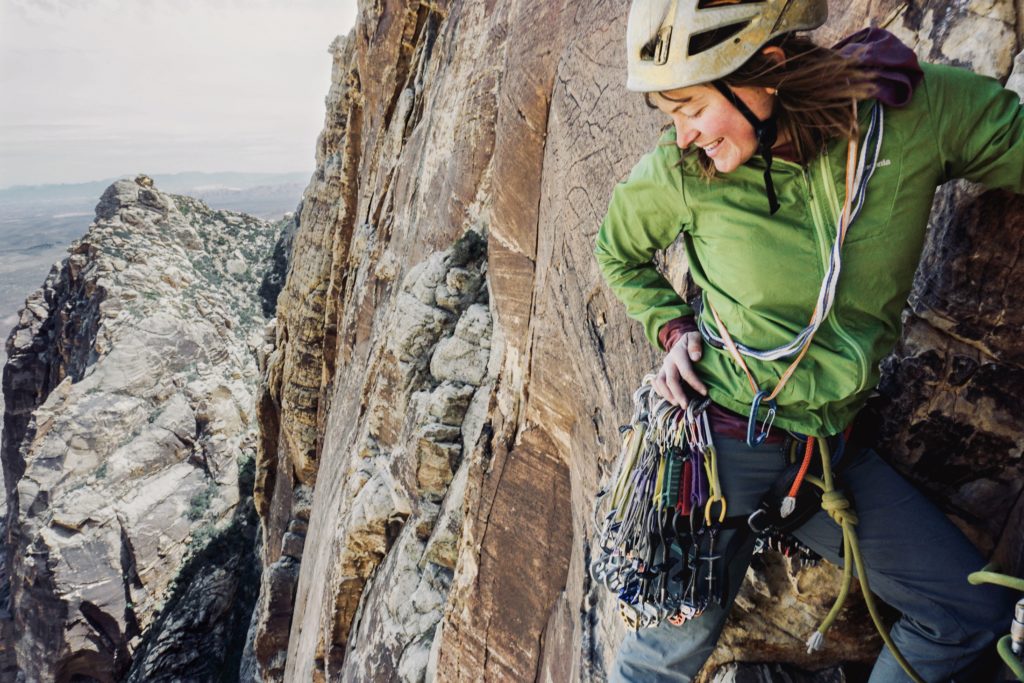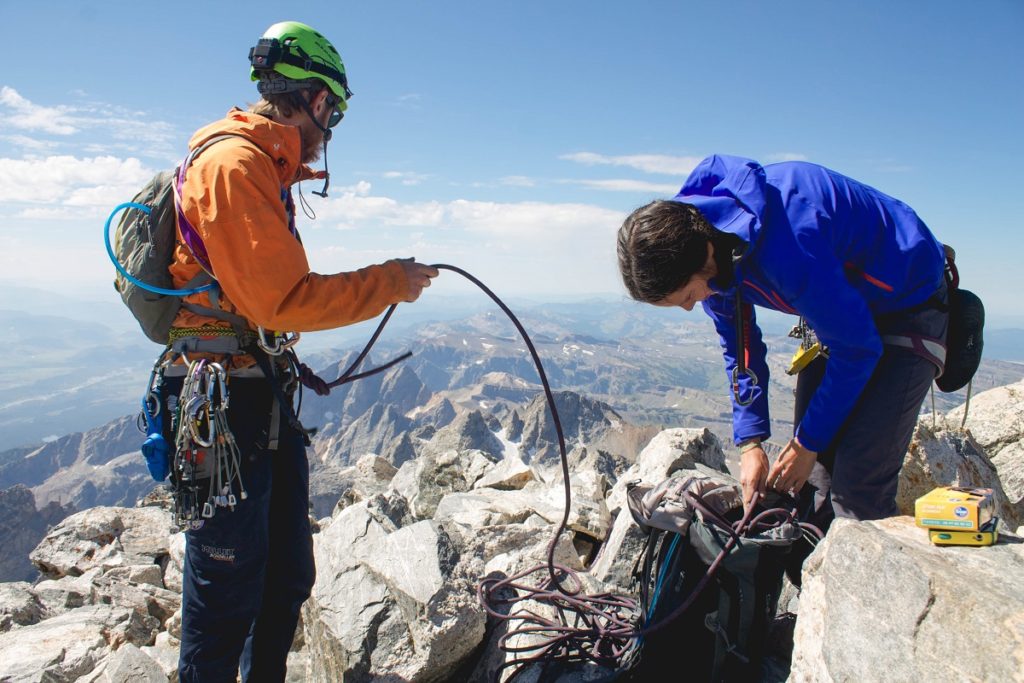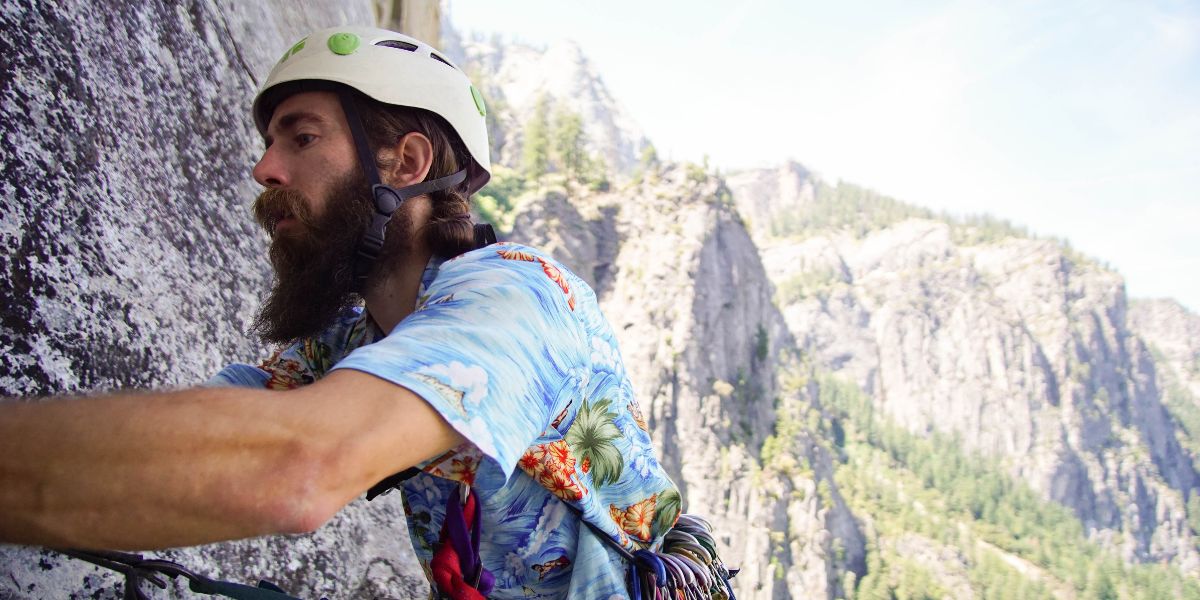Now that you’ve climbed all the cracks you can find at your local crag, have built up the mileage, honed your technique, and placed tons of bomber gear, the next step to getting closer to climbing the hallowed El Capitan is to do a lot of multi-pitch climbing. In this next article in the “Path to Big Wall” series I will explain why learning essential skills for fast transitions and building up the endurance for long days is so important.
Related Post: Path to Big Wall: Part 1: Where to Start?

Annie looks psyched high up on Epinephrine, a 13-pitch route in Red Rocks.
Climbing a multi-day wall is exhilarating. The thousands of feet of air below you, the cascading wall above you, the adrenaline alone is energizing enough to propel you upwards. But after day one, the adrenaline will fade, the nerves will come back full force, and you’ll already be exhausted from a full day of climbing knowing that you have to do it all over again, and again. Your harness will start chaffing from hours of sitting, jugging, hauling, your hands will stiffen and swell (a phenomenon called “wall hands”), the smell of piss will seem to follow you wherever you go, and you’ll have to keep performing while your body protests with aches and pains. No matter how much you prepare, you’re going to suffer on a big wall, it’s part of the game. But how much you suffer can be determined by how efficient you decided to become beforehand, how much endurance you have in the tank from training big days, and a little bit of grit.

Long alpine routes like the Grand Teton are great for honing your skills to cover a lot of terrain and help build up your endurance for big days.
We left off with you becoming a gear-placing wizard and mastering 5.10 crack climbing. The next logical step if you haven’t taken it already, is to go out and get on multi-pitch trad climbs. The key here is to learn how to build anchors quickly, how to do changeovers efficiently, gain good rope management skills, and get used to having bigger days out. These skills are essential, as time is of the essence in big wall climbing, and you must be as proficient and efficient as possible. Anchors must be built quickly and without hesitation and leader changeovers must happen as if you both were on auto-pilot. Any inefficiencies will quickly add up causing an 8-hour climbing day to become a 12-hour one before you know it. You also must be very familiar with untangling ropes, because when your leader line gets hopelessly wrapped around your haul line or bag, it can take excruciatingly long to untangle.
Related Post: 10 Dos and Don’ts for Multi-Pitch Rock Climbing

Anchors on big walls tend to get very chaotic very quickly, as seen in this photo of an anchor from my one day push of the Leaning Tower in Yosemite.
To start, practice these skills on a moderate multi-pitch of 4-6 pitches in length. Start a timer, and if possible, come back to the same route a few more times and gauge how much faster you can do it. While climbing fast is undeniably advantageous, it’s really dialing in your systems that is going to make the difference. Start seeking out longer routes, with 10-12 pitch days being the goal. You need to get familiar with what it feels like to climb all day, and possibly into the night. If you can, climb big, back-to-back days, maybe finding two, 6-8 pitch routes to help build up your fitness and endurance. If sport climbs are all you have nearby, that will be fine for building fitness. But you will need to seek out trad routes to really get better and faster at placing and removing gear (don’t underestimate the removing part). Pro Tip: Come to Yosemite and practice on the incredible amount of roadside moderate multi-pitches we have and get used to the Yosemite style to boot! And you usually get a bonus view of El Cap from up high, so you can stoke the fire of motivation while you’re rappelling in the dark because I told you you had to do a lot, and I mean A LOT of climbing before you can touch the holy granite giant.
Related Post: Essential Gear for Rock Climbing Yosemite
The fitter you are, and the more efficient you can become, will truly make a huge difference in how enjoyable and successful your ascent of El Cap will be. Next time I’ll tell you about what other, more specific skills you’ll need to practice to become a proficient aid climber.
Want more climbing content? Get our awesome climbing newsletter, delivered weekly.
Explore More
Related articles and pages you'll love- Path to Big Wall: Part 1: How to Start Big Wall Climbing?
- Gifts for Rock Climbers
- Sabrina Chapman’s Titan Project
- Training for Rock Climbing
- Moja Gear’s Weekly Gear Picks
- How to Build Your First Trad Rack
- Best Shoes for Bouldering, Sport, and Trad Climbing








